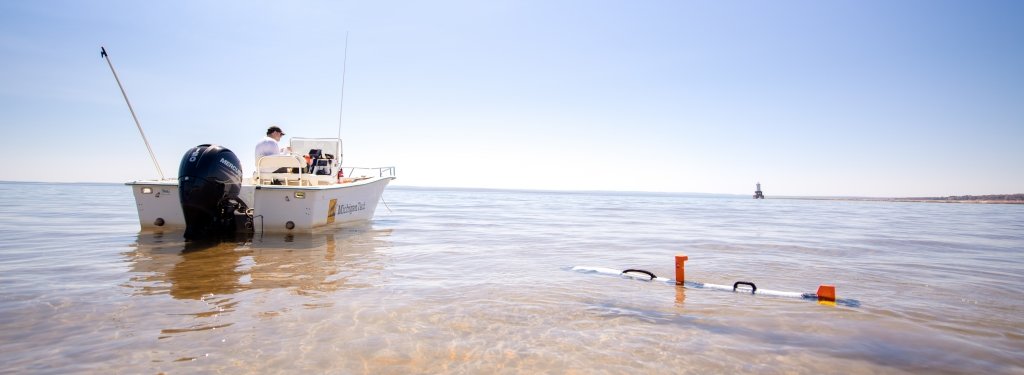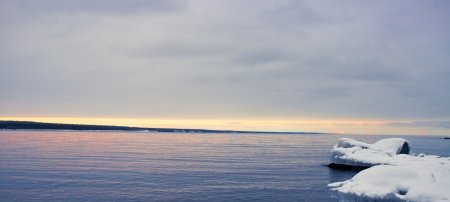Michigan Technological University has joined the Cooperative Institute for Great Lakes Research — a regional consortium dedicated to solving the critical issues facing the Great Lakes and surrounding communities.
For the millions of people who live in the Great Lakes region and along the ocean coasts, the research and work of the National Oceanic and Atmospheric Administration (NOAA) affects their everyday lives. Weather reports, currents and water elevation monitoring and tracking harmful algal blooms are just a few of the services NOAA provides.

Today, Michigan Tech joined the Cooperative Institute for Great Lakes Research (CIGLR). Hosted by the School for Environment and Sustainability at the University of Michigan, CIGLR is one of 16 NOAA-funded cooperative institutes across the United States. CIGLR partners closely with NOAA to achieve environmental, economic and social sustainability in the Great Lakes.
“The overall goal is to make it easier for this group of universities to help NOAA meet their mission and we’re enthusiastic about that,” said Guy Meadows, director of the Great Lakes Research Center at Michigan Tech.
Michigan Tech brings much to the research collaborative, particularly in three key areas: remote sensing, numerical modeling and autonomous vehicle observing systems.
Specifically, Michigan Tech researchers are working on:
- Hydrodynamic and ecological predictive modeling capabilities of the Great Lakes and expanding regional climate models;
- Applying Great Lakes-specific observing platforms and technologies such as cabled observatories with under-ice sensing capabilities, environmental data buoys and aerial, surface and underwater autonomous survey and research platforms;
- Collaborating with the NOAA to develop new and improve existing satellite and aircraft algorithms for Great Lakes monitoring products including water quality, bathymetry and benthic mapping;
- Expanding the Great Lakes Observing System (GLOS) network supporting advanced data acquisition and management;
- Advance autonomous marine technologies through development and application, build on the launch of the Smart Ships Coalitions (SSC) of the Great Lakes-St. Lawrence and opening of the Marine Autonomy Research Site (MARS) on Lake Superior, centered on Michigan Tech’s campus at the Great Lakes Research Center.
The Great Lakes Research Center has 102 members while the Michigan Tech Research Institute in Ann Arbor, Michigan, brings an additional 60 advanced technical staff.
“Geographically, we strengthen the CIGLR team because of our access to Lake Superior, and our location in between Duluth and Lake Superior State University,” said Beth Hoy, assistant director of business & program development at the Great Lakes Research Center.
“Lake Superior is the least studied of the Great Lakes, and the least affected by humans. More than half the water in the Great Lakes system is in Lake Superior,” Meadows added.
Diving Into Research
Michigan Tech researchers have two research missions planned within the next month that already advance the NOAA mission.

Next week, Tech’s buoy 45175 will be deployed in the Straits of Mackinac to provide current and wave monitoring. If the buoy reports waves greater than eight feet, Enbridge is required by the State of Michigan to halt the flow of its crude oil products through the pipeline that runs along the floor of the Straits. This mandate was implemented by Michigan’s former Gov. Rick Snyder. In addition to measuring waves and currents, the buoy measures wind speed and solar radiation, providing 2 million data points during its late April to late October deployment annually, all of which is instantly available to the general public.
In May, Lorelle Meadows, dean of the Pavlis Honors College and oceanographer by training, will deploy two high-frequency radar stations to flank the Straits. These stations will be tested for the next year to determine how well they can provide year-round current monitoring when the buoys are pulled for the winter.
With the addition of Michigan Tech, the Cleveland Water Alliance, Wayne State University and Lake Superior State University, the CIGLR Regional Consortium now consists of 12 universities, four NGOs, and three businesses who partner with NOAA in research and development activities that support the agency’s mission in the Great Lakes.
Michigan Technological University is an R1 public research university founded in 1885 in Houghton, and is home to nearly 7,500 students from more than 60 countries around the world. Consistently ranked among the best universities in the country for return on investment, Michigan's flagship technological university offers more than 185 undergraduate and graduate degree programs in science and technology, engineering, computing, forestry, business, health professions, humanities, mathematics, social sciences, and the arts. The rural campus is situated just miles from Lake Superior in Michigan's Upper Peninsula, offering year-round opportunities for outdoor adventure.






Comments